Comprehensive Analysis of Hospitality Business: A Toolkit Report
VerifiedAdded on 2023/01/13
|14
|3169
|46
Report
AI Summary
This report provides a comprehensive analysis of the hospitality business, focusing on East London Catering. It delves into financial management, including principles of monitoring financial performance, double-entry bookkeeping, and trial balance development. The report also explores the HR lifecycle, detailing stages like recruitment, education, motivation, evaluation, and celebration, and how these impact talent retention and development. Furthermore, it outlines a performance management plan to address negative behaviors within the organization. The report also examines the legal and ethical considerations within the hospitality sector, including relevant legislations such as the Safety Act and Food Act, and how employment, organizational, and contract law influence business decision-making. The conclusion summarizes the key findings and recommendations for East London Catering.
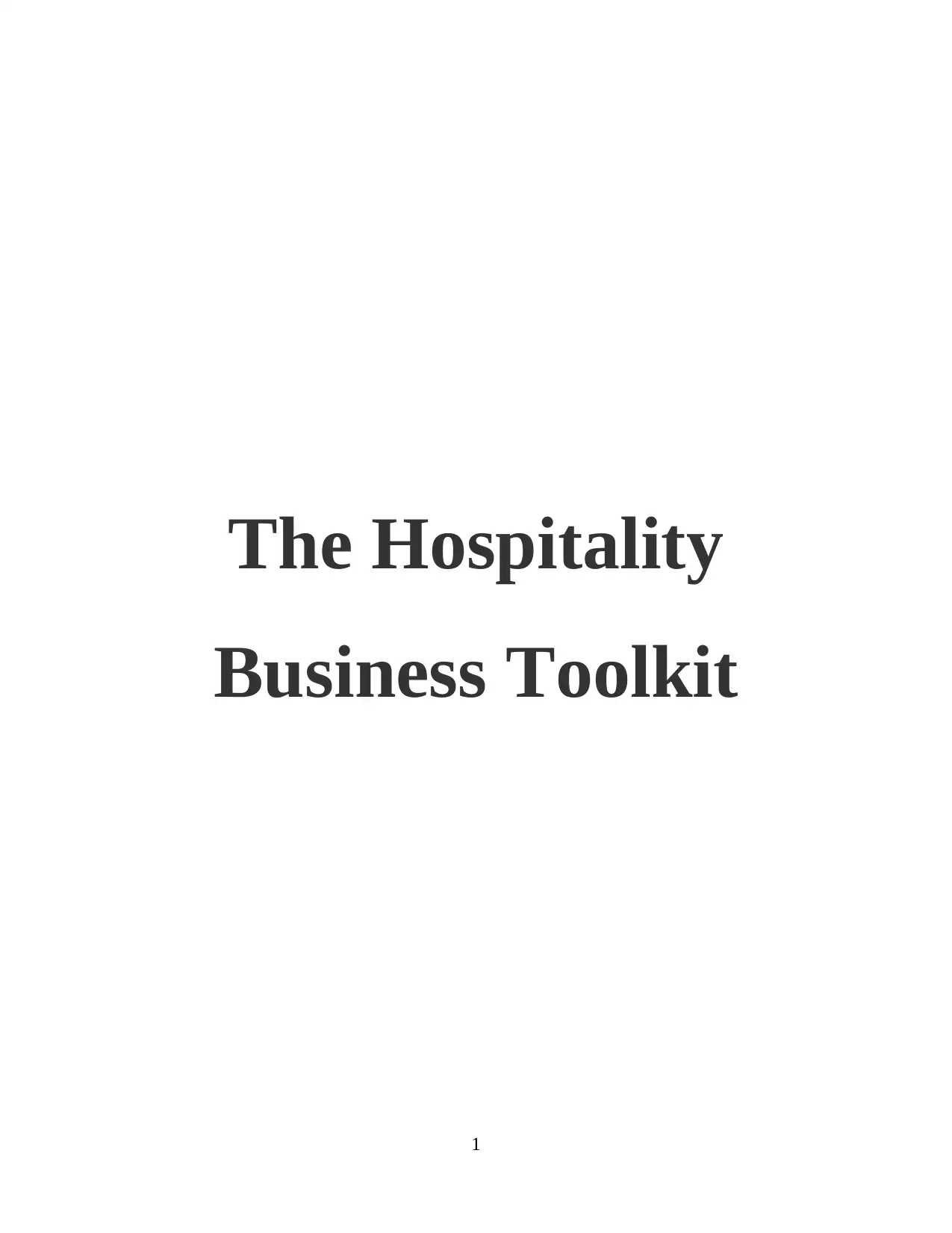
The Hospitality
Business Toolkit
1
Business Toolkit
1
Paraphrase This Document
Need a fresh take? Get an instant paraphrase of this document with our AI Paraphraser
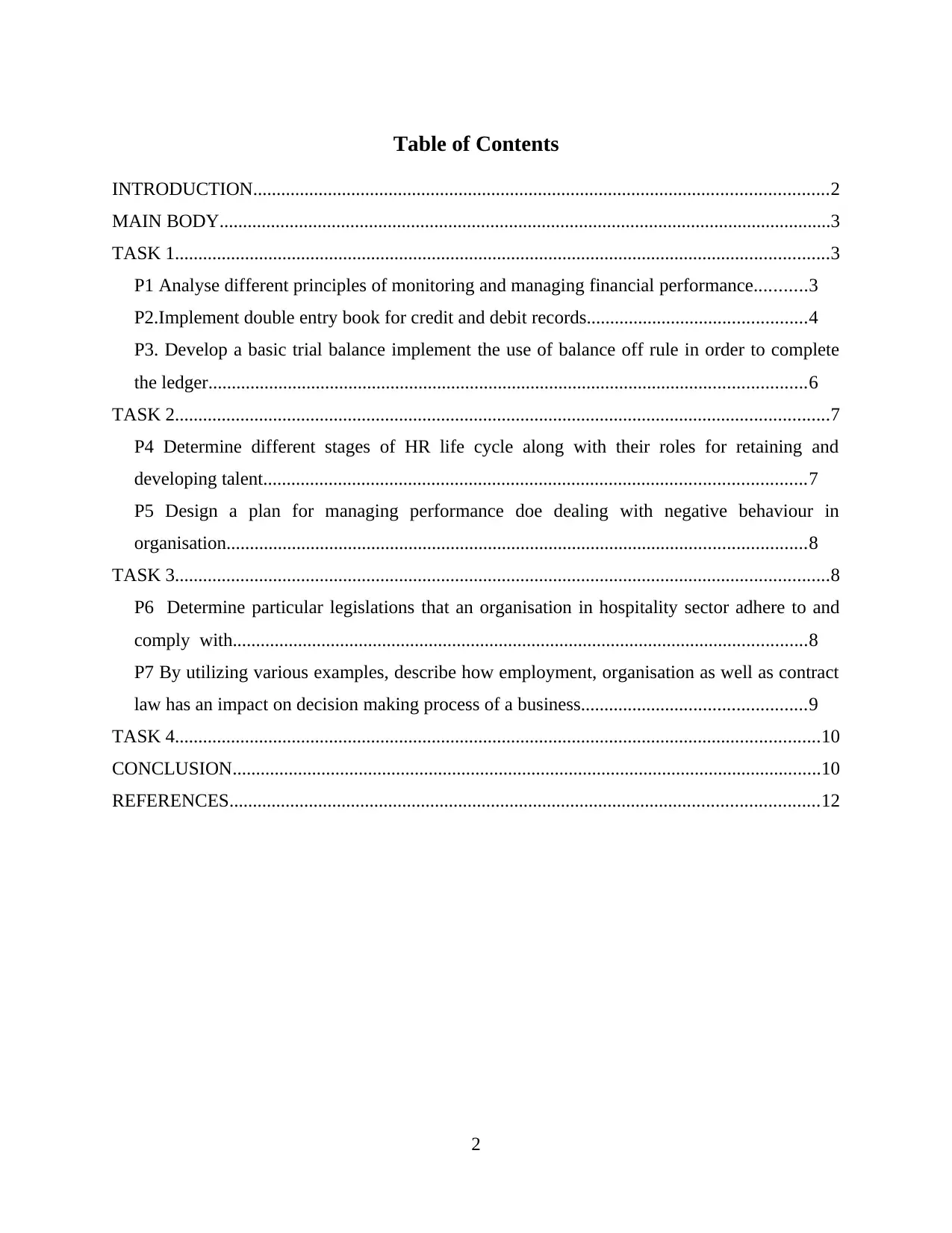
Table of Contents
INTRODUCTION...........................................................................................................................2
MAIN BODY...................................................................................................................................3
TASK 1............................................................................................................................................3
P1 Analyse different principles of monitoring and managing financial performance...........3
P2.Implement double entry book for credit and debit records...............................................4
P3. Develop a basic trial balance implement the use of balance off rule in order to complete
the ledger................................................................................................................................6
TASK 2............................................................................................................................................7
P4 Determine different stages of HR life cycle along with their roles for retaining and
developing talent....................................................................................................................7
P5 Design a plan for managing performance doe dealing with negative behaviour in
organisation............................................................................................................................8
TASK 3............................................................................................................................................8
P6 Determine particular legislations that an organisation in hospitality sector adhere to and
comply with...........................................................................................................................8
P7 By utilizing various examples, describe how employment, organisation as well as contract
law has an impact on decision making process of a business................................................9
TASK 4..........................................................................................................................................10
CONCLUSION..............................................................................................................................10
REFERENCES..............................................................................................................................12
2
INTRODUCTION...........................................................................................................................2
MAIN BODY...................................................................................................................................3
TASK 1............................................................................................................................................3
P1 Analyse different principles of monitoring and managing financial performance...........3
P2.Implement double entry book for credit and debit records...............................................4
P3. Develop a basic trial balance implement the use of balance off rule in order to complete
the ledger................................................................................................................................6
TASK 2............................................................................................................................................7
P4 Determine different stages of HR life cycle along with their roles for retaining and
developing talent....................................................................................................................7
P5 Design a plan for managing performance doe dealing with negative behaviour in
organisation............................................................................................................................8
TASK 3............................................................................................................................................8
P6 Determine particular legislations that an organisation in hospitality sector adhere to and
comply with...........................................................................................................................8
P7 By utilizing various examples, describe how employment, organisation as well as contract
law has an impact on decision making process of a business................................................9
TASK 4..........................................................................................................................................10
CONCLUSION..............................................................................................................................10
REFERENCES..............................................................................................................................12
2
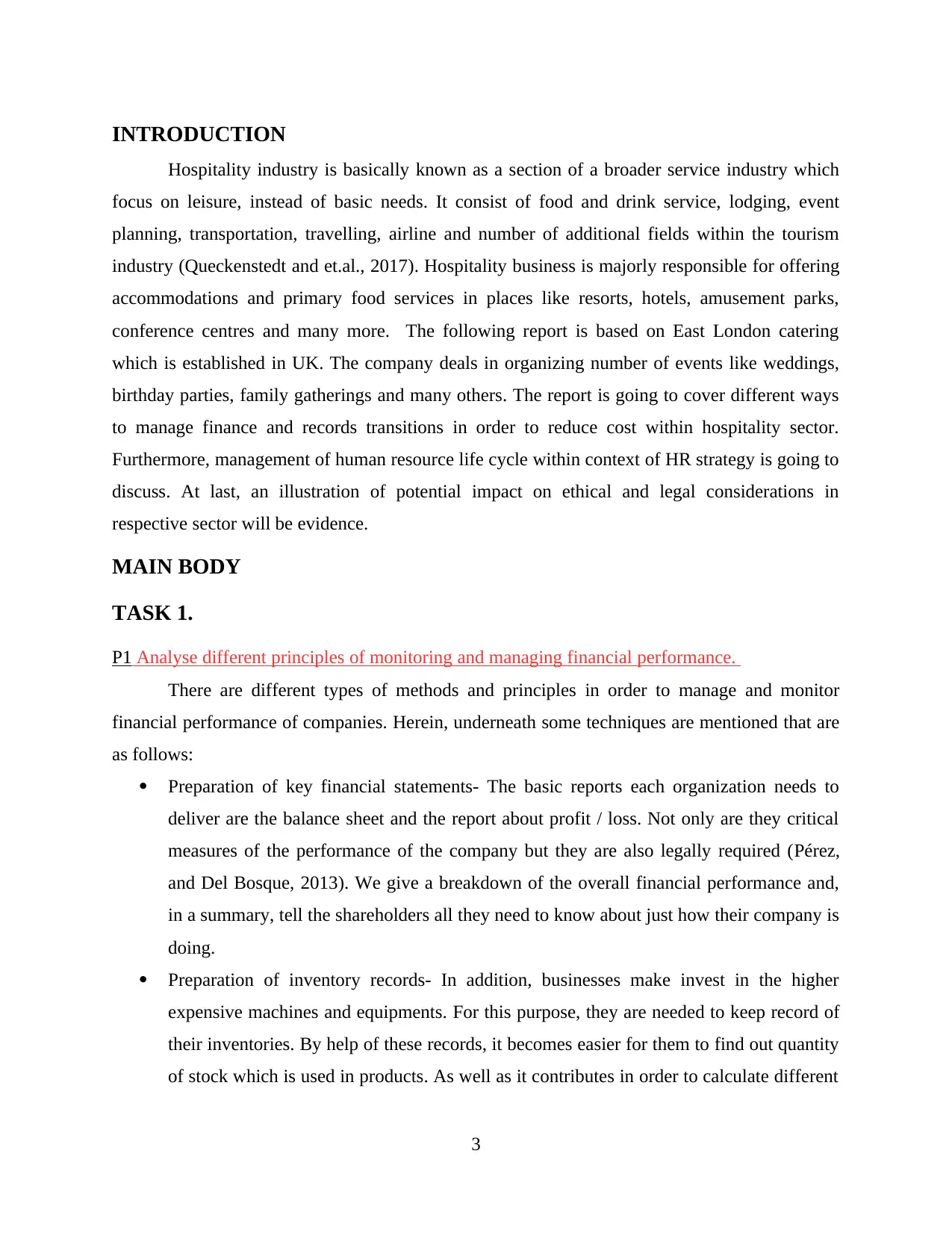
INTRODUCTION
Hospitality industry is basically known as a section of a broader service industry which
focus on leisure, instead of basic needs. It consist of food and drink service, lodging, event
planning, transportation, travelling, airline and number of additional fields within the tourism
industry (Queckenstedt and et.al., 2017). Hospitality business is majorly responsible for offering
accommodations and primary food services in places like resorts, hotels, amusement parks,
conference centres and many more. The following report is based on East London catering
which is established in UK. The company deals in organizing number of events like weddings,
birthday parties, family gatherings and many others. The report is going to cover different ways
to manage finance and records transitions in order to reduce cost within hospitality sector.
Furthermore, management of human resource life cycle within context of HR strategy is going to
discuss. At last, an illustration of potential impact on ethical and legal considerations in
respective sector will be evidence.
MAIN BODY
TASK 1.
P1 Analyse different principles of monitoring and managing financial performance.
There are different types of methods and principles in order to manage and monitor
financial performance of companies. Herein, underneath some techniques are mentioned that are
as follows:
Preparation of key financial statements- The basic reports each organization needs to
deliver are the balance sheet and the report about profit / loss. Not only are they critical
measures of the performance of the company but they are also legally required (Pérez,
and Del Bosque, 2013). We give a breakdown of the overall financial performance and,
in a summary, tell the shareholders all they need to know about just how their company is
doing.
Preparation of inventory records- In addition, businesses make invest in the higher
expensive machines and equipments. For this purpose, they are needed to keep record of
their inventories. By help of these records, it becomes easier for them to find out quantity
of stock which is used in products. As well as it contributes in order to calculate different
3
Hospitality industry is basically known as a section of a broader service industry which
focus on leisure, instead of basic needs. It consist of food and drink service, lodging, event
planning, transportation, travelling, airline and number of additional fields within the tourism
industry (Queckenstedt and et.al., 2017). Hospitality business is majorly responsible for offering
accommodations and primary food services in places like resorts, hotels, amusement parks,
conference centres and many more. The following report is based on East London catering
which is established in UK. The company deals in organizing number of events like weddings,
birthday parties, family gatherings and many others. The report is going to cover different ways
to manage finance and records transitions in order to reduce cost within hospitality sector.
Furthermore, management of human resource life cycle within context of HR strategy is going to
discuss. At last, an illustration of potential impact on ethical and legal considerations in
respective sector will be evidence.
MAIN BODY
TASK 1.
P1 Analyse different principles of monitoring and managing financial performance.
There are different types of methods and principles in order to manage and monitor
financial performance of companies. Herein, underneath some techniques are mentioned that are
as follows:
Preparation of key financial statements- The basic reports each organization needs to
deliver are the balance sheet and the report about profit / loss. Not only are they critical
measures of the performance of the company but they are also legally required (Pérez,
and Del Bosque, 2013). We give a breakdown of the overall financial performance and,
in a summary, tell the shareholders all they need to know about just how their company is
doing.
Preparation of inventory records- In addition, businesses make invest in the higher
expensive machines and equipments. For this purpose, they are needed to keep record of
their inventories. By help of these records, it becomes easier for them to find out quantity
of stock which is used in products. As well as it contributes in order to calculate different
3
⊘ This is a preview!⊘
Do you want full access?
Subscribe today to unlock all pages.

Trusted by 1+ million students worldwide
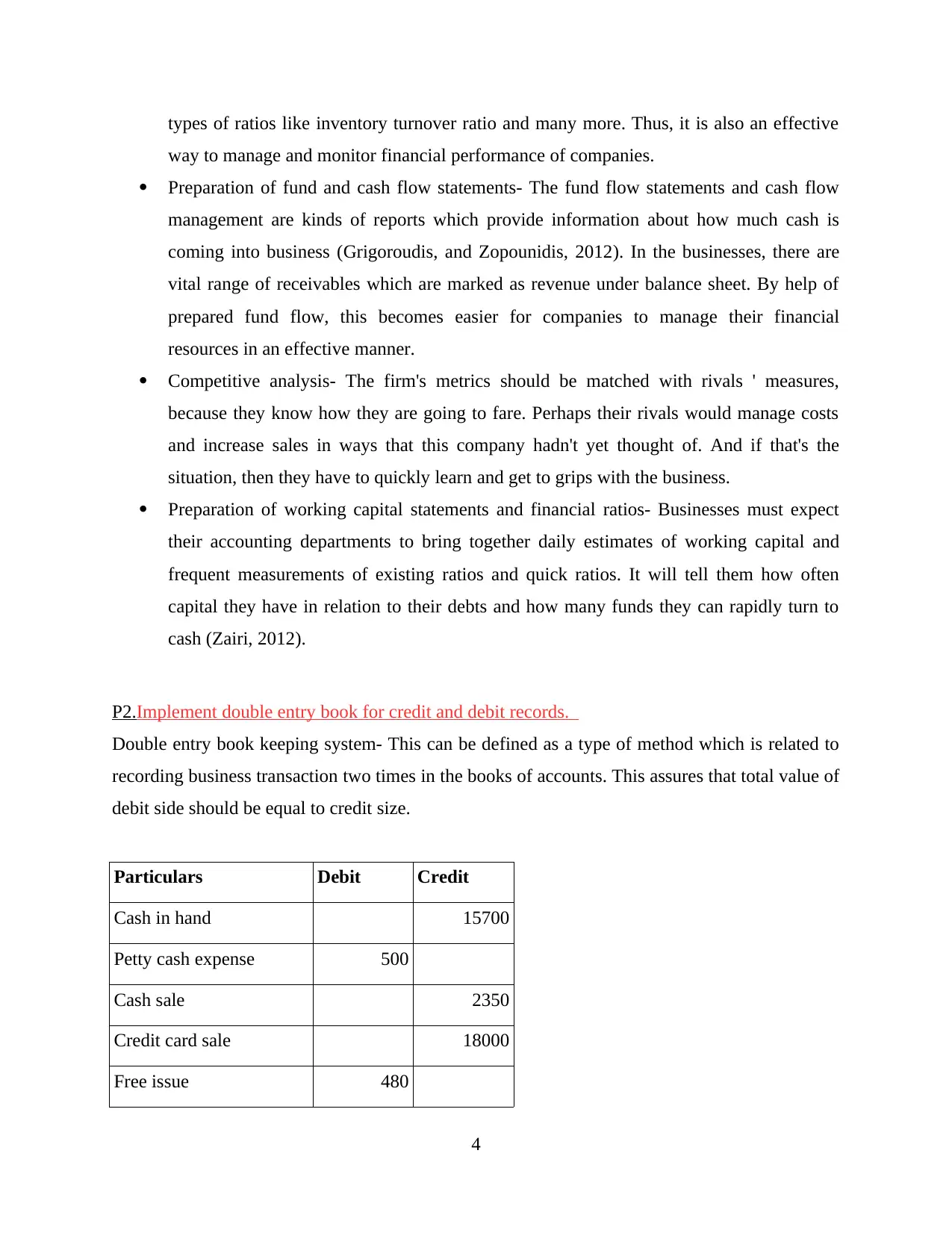
types of ratios like inventory turnover ratio and many more. Thus, it is also an effective
way to manage and monitor financial performance of companies.
Preparation of fund and cash flow statements- The fund flow statements and cash flow
management are kinds of reports which provide information about how much cash is
coming into business (Grigoroudis, and Zopounidis, 2012). In the businesses, there are
vital range of receivables which are marked as revenue under balance sheet. By help of
prepared fund flow, this becomes easier for companies to manage their financial
resources in an effective manner.
Competitive analysis- The firm's metrics should be matched with rivals ' measures,
because they know how they are going to fare. Perhaps their rivals would manage costs
and increase sales in ways that this company hadn't yet thought of. And if that's the
situation, then they have to quickly learn and get to grips with the business.
Preparation of working capital statements and financial ratios- Businesses must expect
their accounting departments to bring together daily estimates of working capital and
frequent measurements of existing ratios and quick ratios. It will tell them how often
capital they have in relation to their debts and how many funds they can rapidly turn to
cash (Zairi, 2012).
P2.Implement double entry book for credit and debit records.
Double entry book keeping system- This can be defined as a type of method which is related to
recording business transaction two times in the books of accounts. This assures that total value of
debit side should be equal to credit size.
Particulars Debit Credit
Cash in hand 15700
Petty cash expense 500
Cash sale 2350
Credit card sale 18000
Free issue 480
4
way to manage and monitor financial performance of companies.
Preparation of fund and cash flow statements- The fund flow statements and cash flow
management are kinds of reports which provide information about how much cash is
coming into business (Grigoroudis, and Zopounidis, 2012). In the businesses, there are
vital range of receivables which are marked as revenue under balance sheet. By help of
prepared fund flow, this becomes easier for companies to manage their financial
resources in an effective manner.
Competitive analysis- The firm's metrics should be matched with rivals ' measures,
because they know how they are going to fare. Perhaps their rivals would manage costs
and increase sales in ways that this company hadn't yet thought of. And if that's the
situation, then they have to quickly learn and get to grips with the business.
Preparation of working capital statements and financial ratios- Businesses must expect
their accounting departments to bring together daily estimates of working capital and
frequent measurements of existing ratios and quick ratios. It will tell them how often
capital they have in relation to their debts and how many funds they can rapidly turn to
cash (Zairi, 2012).
P2.Implement double entry book for credit and debit records.
Double entry book keeping system- This can be defined as a type of method which is related to
recording business transaction two times in the books of accounts. This assures that total value of
debit side should be equal to credit size.
Particulars Debit Credit
Cash in hand 15700
Petty cash expense 500
Cash sale 2350
Credit card sale 18000
Free issue 480
4
Paraphrase This Document
Need a fresh take? Get an instant paraphrase of this document with our AI Paraphraser
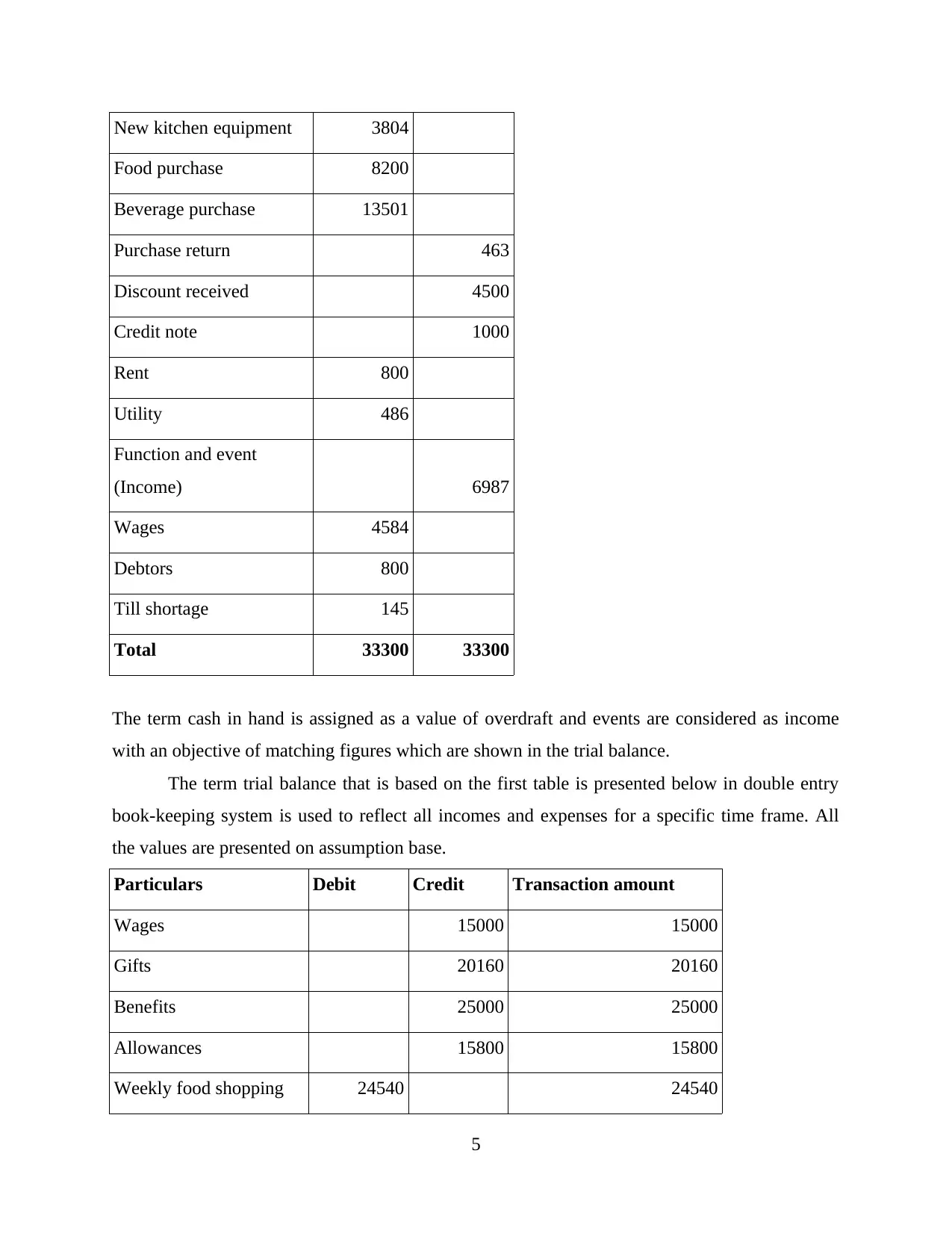
New kitchen equipment 3804
Food purchase 8200
Beverage purchase 13501
Purchase return 463
Discount received 4500
Credit note 1000
Rent 800
Utility 486
Function and event
(Income) 6987
Wages 4584
Debtors 800
Till shortage 145
Total 33300 33300
The term cash in hand is assigned as a value of overdraft and events are considered as income
with an objective of matching figures which are shown in the trial balance.
The term trial balance that is based on the first table is presented below in double entry
book-keeping system is used to reflect all incomes and expenses for a specific time frame. All
the values are presented on assumption base.
Particulars Debit Credit Transaction amount
Wages 15000 15000
Gifts 20160 20160
Benefits 25000 25000
Allowances 15800 15800
Weekly food shopping 24540 24540
5
Food purchase 8200
Beverage purchase 13501
Purchase return 463
Discount received 4500
Credit note 1000
Rent 800
Utility 486
Function and event
(Income) 6987
Wages 4584
Debtors 800
Till shortage 145
Total 33300 33300
The term cash in hand is assigned as a value of overdraft and events are considered as income
with an objective of matching figures which are shown in the trial balance.
The term trial balance that is based on the first table is presented below in double entry
book-keeping system is used to reflect all incomes and expenses for a specific time frame. All
the values are presented on assumption base.
Particulars Debit Credit Transaction amount
Wages 15000 15000
Gifts 20160 20160
Benefits 25000 25000
Allowances 15800 15800
Weekly food shopping 24540 24540
5
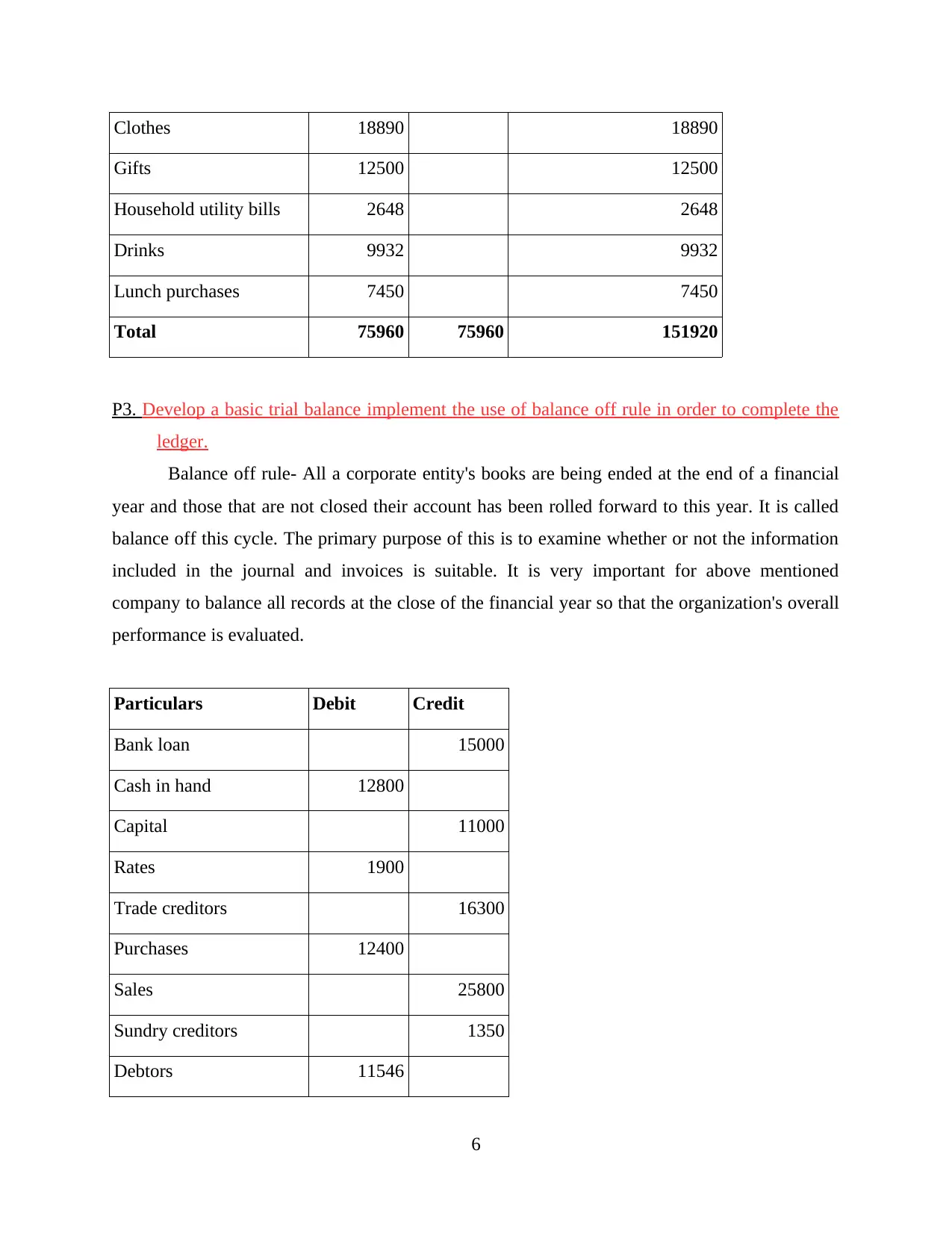
Clothes 18890 18890
Gifts 12500 12500
Household utility bills 2648 2648
Drinks 9932 9932
Lunch purchases 7450 7450
Total 75960 75960 151920
P3. Develop a basic trial balance implement the use of balance off rule in order to complete the
ledger.
Balance off rule- All a corporate entity's books are being ended at the end of a financial
year and those that are not closed their account has been rolled forward to this year. It is called
balance off this cycle. The primary purpose of this is to examine whether or not the information
included in the journal and invoices is suitable. It is very important for above mentioned
company to balance all records at the close of the financial year so that the organization's overall
performance is evaluated.
Particulars Debit Credit
Bank loan 15000
Cash in hand 12800
Capital 11000
Rates 1900
Trade creditors 16300
Purchases 12400
Sales 25800
Sundry creditors 1350
Debtors 11546
6
Gifts 12500 12500
Household utility bills 2648 2648
Drinks 9932 9932
Lunch purchases 7450 7450
Total 75960 75960 151920
P3. Develop a basic trial balance implement the use of balance off rule in order to complete the
ledger.
Balance off rule- All a corporate entity's books are being ended at the end of a financial
year and those that are not closed their account has been rolled forward to this year. It is called
balance off this cycle. The primary purpose of this is to examine whether or not the information
included in the journal and invoices is suitable. It is very important for above mentioned
company to balance all records at the close of the financial year so that the organization's overall
performance is evaluated.
Particulars Debit Credit
Bank loan 15000
Cash in hand 12800
Capital 11000
Rates 1900
Trade creditors 16300
Purchases 12400
Sales 25800
Sundry creditors 1350
Debtors 11546
6
⊘ This is a preview!⊘
Do you want full access?
Subscribe today to unlock all pages.

Trusted by 1+ million students worldwide
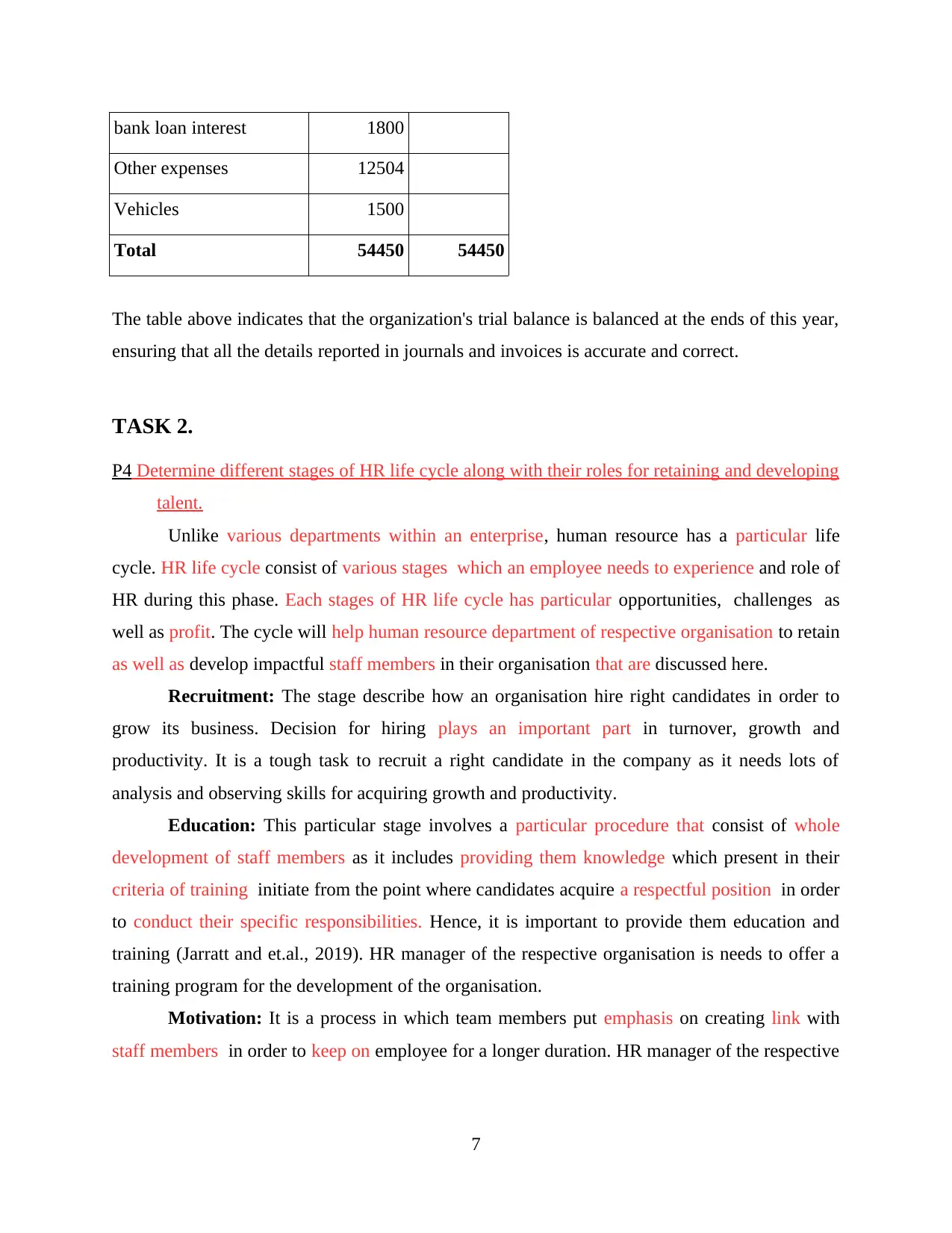
bank loan interest 1800
Other expenses 12504
Vehicles 1500
Total 54450 54450
The table above indicates that the organization's trial balance is balanced at the ends of this year,
ensuring that all the details reported in journals and invoices is accurate and correct.
TASK 2.
P4 Determine different stages of HR life cycle along with their roles for retaining and developing
talent.
Unlike various departments within an enterprise, human resource has a particular life
cycle. HR life cycle consist of various stages which an employee needs to experience and role of
HR during this phase. Each stages of HR life cycle has particular opportunities, challenges as
well as profit. The cycle will help human resource department of respective organisation to retain
as well as develop impactful staff members in their organisation that are discussed here.
Recruitment: The stage describe how an organisation hire right candidates in order to
grow its business. Decision for hiring plays an important part in turnover, growth and
productivity. It is a tough task to recruit a right candidate in the company as it needs lots of
analysis and observing skills for acquiring growth and productivity.
Education: This particular stage involves a particular procedure that consist of whole
development of staff members as it includes providing them knowledge which present in their
criteria of training initiate from the point where candidates acquire a respectful position in order
to conduct their specific responsibilities. Hence, it is important to provide them education and
training (Jarratt and et.al., 2019). HR manager of the respective organisation is needs to offer a
training program for the development of the organisation.
Motivation: It is a process in which team members put emphasis on creating link with
staff members in order to keep on employee for a longer duration. HR manager of the respective
7
Other expenses 12504
Vehicles 1500
Total 54450 54450
The table above indicates that the organization's trial balance is balanced at the ends of this year,
ensuring that all the details reported in journals and invoices is accurate and correct.
TASK 2.
P4 Determine different stages of HR life cycle along with their roles for retaining and developing
talent.
Unlike various departments within an enterprise, human resource has a particular life
cycle. HR life cycle consist of various stages which an employee needs to experience and role of
HR during this phase. Each stages of HR life cycle has particular opportunities, challenges as
well as profit. The cycle will help human resource department of respective organisation to retain
as well as develop impactful staff members in their organisation that are discussed here.
Recruitment: The stage describe how an organisation hire right candidates in order to
grow its business. Decision for hiring plays an important part in turnover, growth and
productivity. It is a tough task to recruit a right candidate in the company as it needs lots of
analysis and observing skills for acquiring growth and productivity.
Education: This particular stage involves a particular procedure that consist of whole
development of staff members as it includes providing them knowledge which present in their
criteria of training initiate from the point where candidates acquire a respectful position in order
to conduct their specific responsibilities. Hence, it is important to provide them education and
training (Jarratt and et.al., 2019). HR manager of the respective organisation is needs to offer a
training program for the development of the organisation.
Motivation: It is a process in which team members put emphasis on creating link with
staff members in order to keep on employee for a longer duration. HR manager of the respective
7
Paraphrase This Document
Need a fresh take? Get an instant paraphrase of this document with our AI Paraphraser
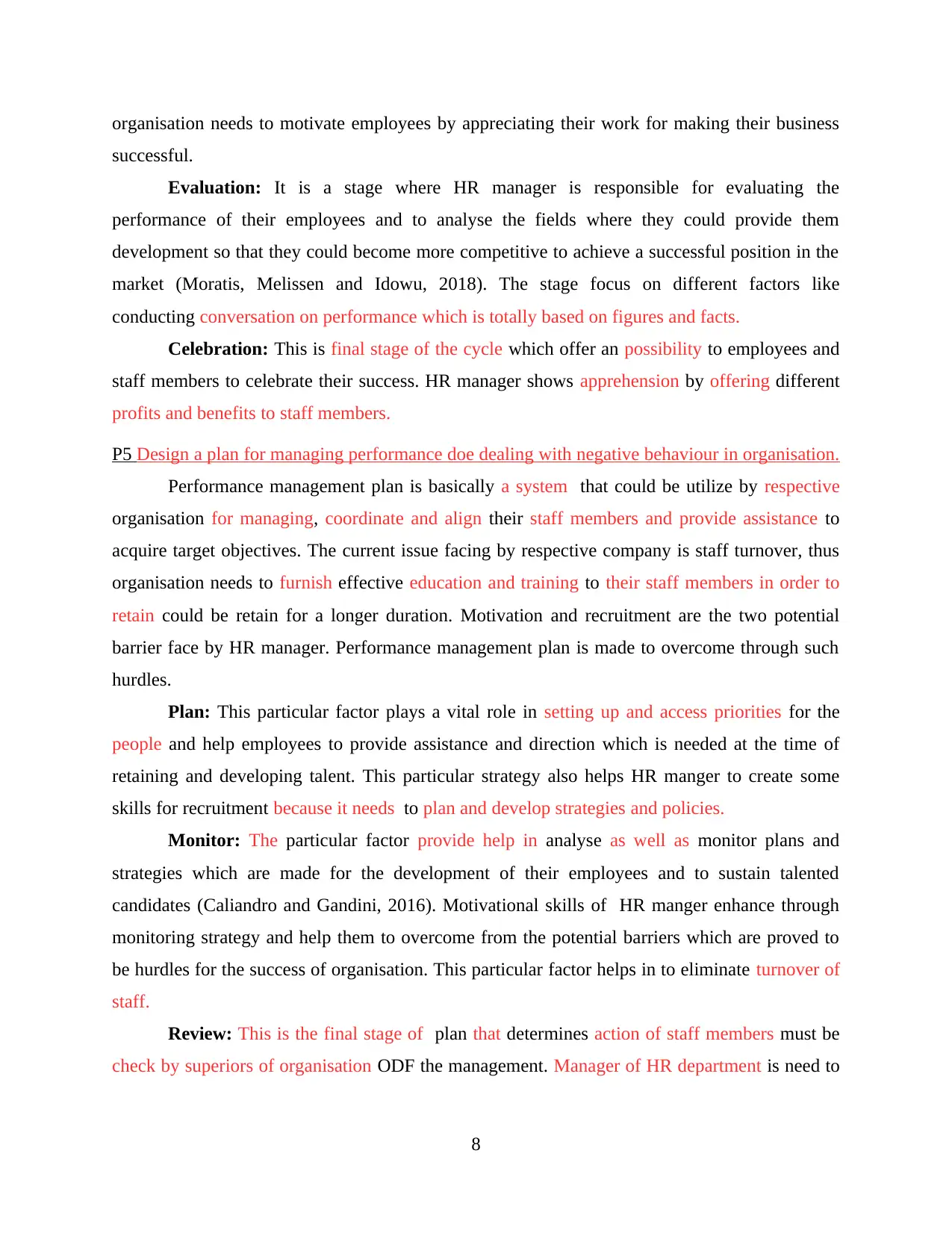
organisation needs to motivate employees by appreciating their work for making their business
successful.
Evaluation: It is a stage where HR manager is responsible for evaluating the
performance of their employees and to analyse the fields where they could provide them
development so that they could become more competitive to achieve a successful position in the
market (Moratis, Melissen and Idowu, 2018). The stage focus on different factors like
conducting conversation on performance which is totally based on figures and facts.
Celebration: This is final stage of the cycle which offer an possibility to employees and
staff members to celebrate their success. HR manager shows apprehension by offering different
profits and benefits to staff members.
P5 Design a plan for managing performance doe dealing with negative behaviour in organisation.
Performance management plan is basically a system that could be utilize by respective
organisation for managing, coordinate and align their staff members and provide assistance to
acquire target objectives. The current issue facing by respective company is staff turnover, thus
organisation needs to furnish effective education and training to their staff members in order to
retain could be retain for a longer duration. Motivation and recruitment are the two potential
barrier face by HR manager. Performance management plan is made to overcome through such
hurdles.
Plan: This particular factor plays a vital role in setting up and access priorities for the
people and help employees to provide assistance and direction which is needed at the time of
retaining and developing talent. This particular strategy also helps HR manger to create some
skills for recruitment because it needs to plan and develop strategies and policies.
Monitor: The particular factor provide help in analyse as well as monitor plans and
strategies which are made for the development of their employees and to sustain talented
candidates (Caliandro and Gandini, 2016). Motivational skills of HR manger enhance through
monitoring strategy and help them to overcome from the potential barriers which are proved to
be hurdles for the success of organisation. This particular factor helps in to eliminate turnover of
staff.
Review: This is the final stage of plan that determines action of staff members must be
check by superiors of organisation ODF the management. Manager of HR department is need to
8
successful.
Evaluation: It is a stage where HR manager is responsible for evaluating the
performance of their employees and to analyse the fields where they could provide them
development so that they could become more competitive to achieve a successful position in the
market (Moratis, Melissen and Idowu, 2018). The stage focus on different factors like
conducting conversation on performance which is totally based on figures and facts.
Celebration: This is final stage of the cycle which offer an possibility to employees and
staff members to celebrate their success. HR manager shows apprehension by offering different
profits and benefits to staff members.
P5 Design a plan for managing performance doe dealing with negative behaviour in organisation.
Performance management plan is basically a system that could be utilize by respective
organisation for managing, coordinate and align their staff members and provide assistance to
acquire target objectives. The current issue facing by respective company is staff turnover, thus
organisation needs to furnish effective education and training to their staff members in order to
retain could be retain for a longer duration. Motivation and recruitment are the two potential
barrier face by HR manager. Performance management plan is made to overcome through such
hurdles.
Plan: This particular factor plays a vital role in setting up and access priorities for the
people and help employees to provide assistance and direction which is needed at the time of
retaining and developing talent. This particular strategy also helps HR manger to create some
skills for recruitment because it needs to plan and develop strategies and policies.
Monitor: The particular factor provide help in analyse as well as monitor plans and
strategies which are made for the development of their employees and to sustain talented
candidates (Caliandro and Gandini, 2016). Motivational skills of HR manger enhance through
monitoring strategy and help them to overcome from the potential barriers which are proved to
be hurdles for the success of organisation. This particular factor helps in to eliminate turnover of
staff.
Review: This is the final stage of plan that determines action of staff members must be
check by superiors of organisation ODF the management. Manager of HR department is need to
8
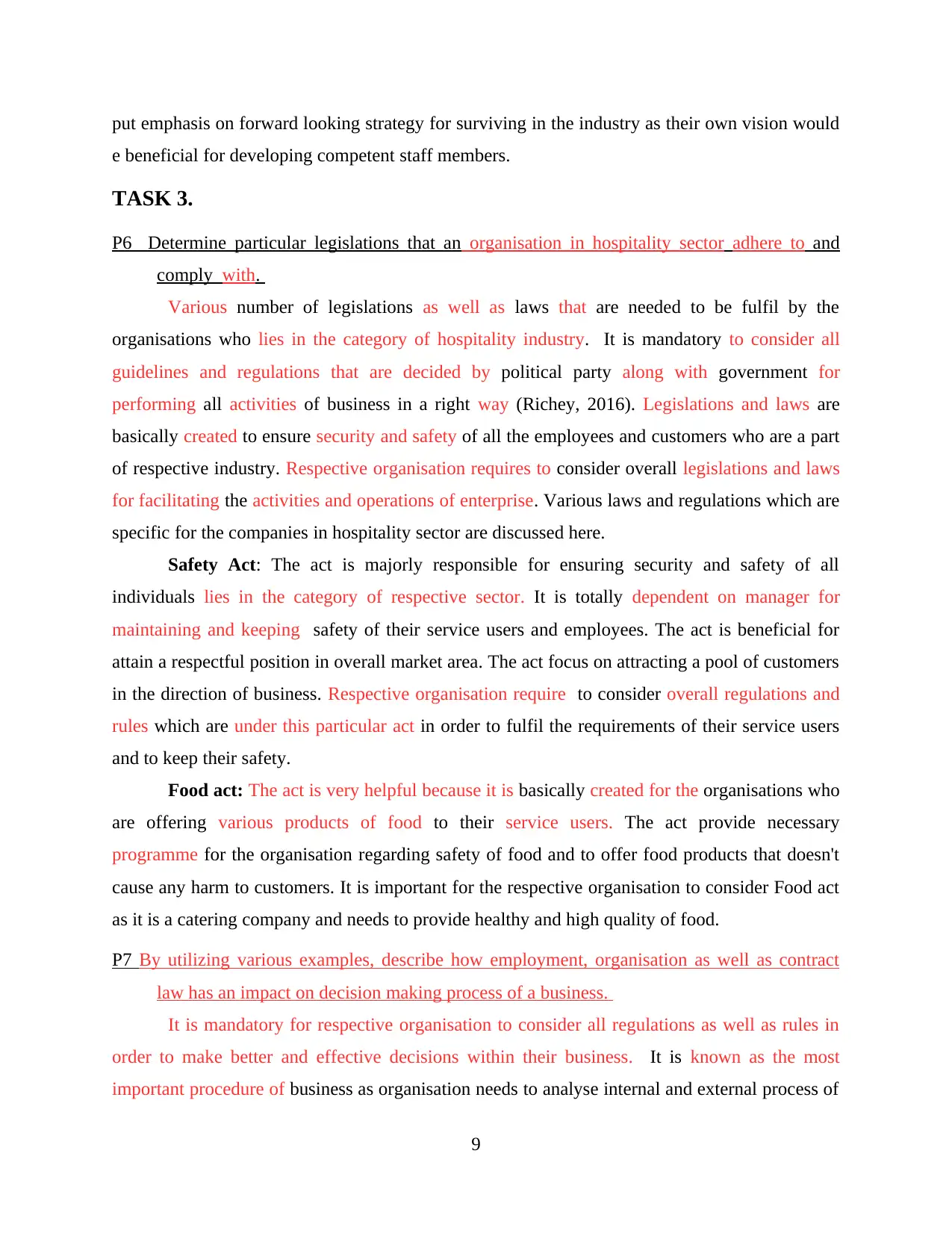
put emphasis on forward looking strategy for surviving in the industry as their own vision would
e beneficial for developing competent staff members.
TASK 3.
P6 Determine particular legislations that an organisation in hospitality sector adhere to and
comply with.
Various number of legislations as well as laws that are needed to be fulfil by the
organisations who lies in the category of hospitality industry. It is mandatory to consider all
guidelines and regulations that are decided by political party along with government for
performing all activities of business in a right way (Richey, 2016). Legislations and laws are
basically created to ensure security and safety of all the employees and customers who are a part
of respective industry. Respective organisation requires to consider overall legislations and laws
for facilitating the activities and operations of enterprise. Various laws and regulations which are
specific for the companies in hospitality sector are discussed here.
Safety Act: The act is majorly responsible for ensuring security and safety of all
individuals lies in the category of respective sector. It is totally dependent on manager for
maintaining and keeping safety of their service users and employees. The act is beneficial for
attain a respectful position in overall market area. The act focus on attracting a pool of customers
in the direction of business. Respective organisation require to consider overall regulations and
rules which are under this particular act in order to fulfil the requirements of their service users
and to keep their safety.
Food act: The act is very helpful because it is basically created for the organisations who
are offering various products of food to their service users. The act provide necessary
programme for the organisation regarding safety of food and to offer food products that doesn't
cause any harm to customers. It is important for the respective organisation to consider Food act
as it is a catering company and needs to provide healthy and high quality of food.
P7 By utilizing various examples, describe how employment, organisation as well as contract
law has an impact on decision making process of a business.
It is mandatory for respective organisation to consider all regulations as well as rules in
order to make better and effective decisions within their business. It is known as the most
important procedure of business as organisation needs to analyse internal and external process of
9
e beneficial for developing competent staff members.
TASK 3.
P6 Determine particular legislations that an organisation in hospitality sector adhere to and
comply with.
Various number of legislations as well as laws that are needed to be fulfil by the
organisations who lies in the category of hospitality industry. It is mandatory to consider all
guidelines and regulations that are decided by political party along with government for
performing all activities of business in a right way (Richey, 2016). Legislations and laws are
basically created to ensure security and safety of all the employees and customers who are a part
of respective industry. Respective organisation requires to consider overall legislations and laws
for facilitating the activities and operations of enterprise. Various laws and regulations which are
specific for the companies in hospitality sector are discussed here.
Safety Act: The act is majorly responsible for ensuring security and safety of all
individuals lies in the category of respective sector. It is totally dependent on manager for
maintaining and keeping safety of their service users and employees. The act is beneficial for
attain a respectful position in overall market area. The act focus on attracting a pool of customers
in the direction of business. Respective organisation require to consider overall regulations and
rules which are under this particular act in order to fulfil the requirements of their service users
and to keep their safety.
Food act: The act is very helpful because it is basically created for the organisations who
are offering various products of food to their service users. The act provide necessary
programme for the organisation regarding safety of food and to offer food products that doesn't
cause any harm to customers. It is important for the respective organisation to consider Food act
as it is a catering company and needs to provide healthy and high quality of food.
P7 By utilizing various examples, describe how employment, organisation as well as contract
law has an impact on decision making process of a business.
It is mandatory for respective organisation to consider all regulations as well as rules in
order to make better and effective decisions within their business. It is known as the most
important procedure of business as organisation needs to analyse internal and external process of
9
⊘ This is a preview!⊘
Do you want full access?
Subscribe today to unlock all pages.

Trusted by 1+ million students worldwide
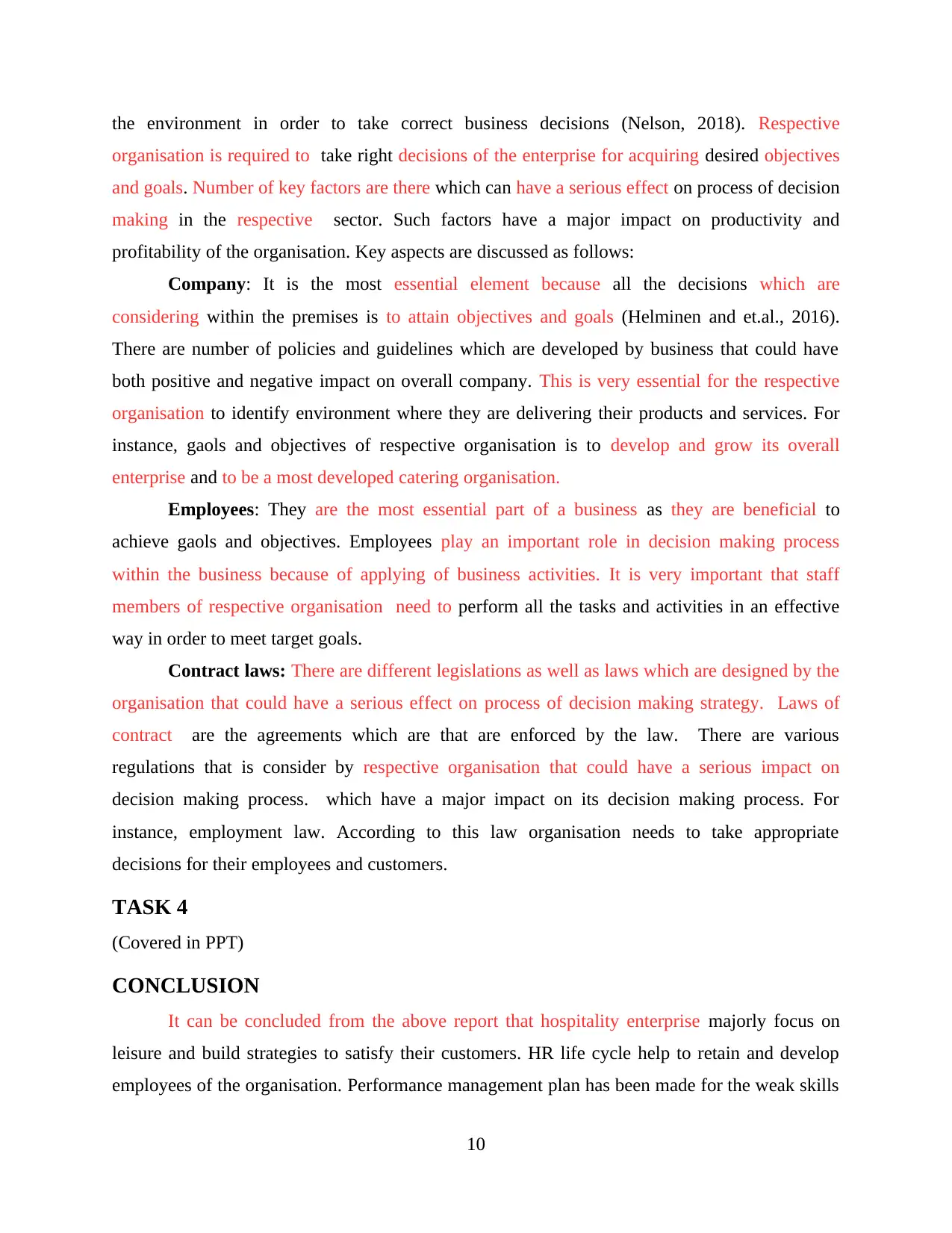
the environment in order to take correct business decisions (Nelson, 2018). Respective
organisation is required to take right decisions of the enterprise for acquiring desired objectives
and goals. Number of key factors are there which can have a serious effect on process of decision
making in the respective sector. Such factors have a major impact on productivity and
profitability of the organisation. Key aspects are discussed as follows:
Company: It is the most essential element because all the decisions which are
considering within the premises is to attain objectives and goals (Helminen and et.al., 2016).
There are number of policies and guidelines which are developed by business that could have
both positive and negative impact on overall company. This is very essential for the respective
organisation to identify environment where they are delivering their products and services. For
instance, gaols and objectives of respective organisation is to develop and grow its overall
enterprise and to be a most developed catering organisation.
Employees: They are the most essential part of a business as they are beneficial to
achieve gaols and objectives. Employees play an important role in decision making process
within the business because of applying of business activities. It is very important that staff
members of respective organisation need to perform all the tasks and activities in an effective
way in order to meet target goals.
Contract laws: There are different legislations as well as laws which are designed by the
organisation that could have a serious effect on process of decision making strategy. Laws of
contract are the agreements which are that are enforced by the law. There are various
regulations that is consider by respective organisation that could have a serious impact on
decision making process. which have a major impact on its decision making process. For
instance, employment law. According to this law organisation needs to take appropriate
decisions for their employees and customers.
TASK 4
(Covered in PPT)
CONCLUSION
It can be concluded from the above report that hospitality enterprise majorly focus on
leisure and build strategies to satisfy their customers. HR life cycle help to retain and develop
employees of the organisation. Performance management plan has been made for the weak skills
10
organisation is required to take right decisions of the enterprise for acquiring desired objectives
and goals. Number of key factors are there which can have a serious effect on process of decision
making in the respective sector. Such factors have a major impact on productivity and
profitability of the organisation. Key aspects are discussed as follows:
Company: It is the most essential element because all the decisions which are
considering within the premises is to attain objectives and goals (Helminen and et.al., 2016).
There are number of policies and guidelines which are developed by business that could have
both positive and negative impact on overall company. This is very essential for the respective
organisation to identify environment where they are delivering their products and services. For
instance, gaols and objectives of respective organisation is to develop and grow its overall
enterprise and to be a most developed catering organisation.
Employees: They are the most essential part of a business as they are beneficial to
achieve gaols and objectives. Employees play an important role in decision making process
within the business because of applying of business activities. It is very important that staff
members of respective organisation need to perform all the tasks and activities in an effective
way in order to meet target goals.
Contract laws: There are different legislations as well as laws which are designed by the
organisation that could have a serious effect on process of decision making strategy. Laws of
contract are the agreements which are that are enforced by the law. There are various
regulations that is consider by respective organisation that could have a serious impact on
decision making process. which have a major impact on its decision making process. For
instance, employment law. According to this law organisation needs to take appropriate
decisions for their employees and customers.
TASK 4
(Covered in PPT)
CONCLUSION
It can be concluded from the above report that hospitality enterprise majorly focus on
leisure and build strategies to satisfy their customers. HR life cycle help to retain and develop
employees of the organisation. Performance management plan has been made for the weak skills
10
Paraphrase This Document
Need a fresh take? Get an instant paraphrase of this document with our AI Paraphraser
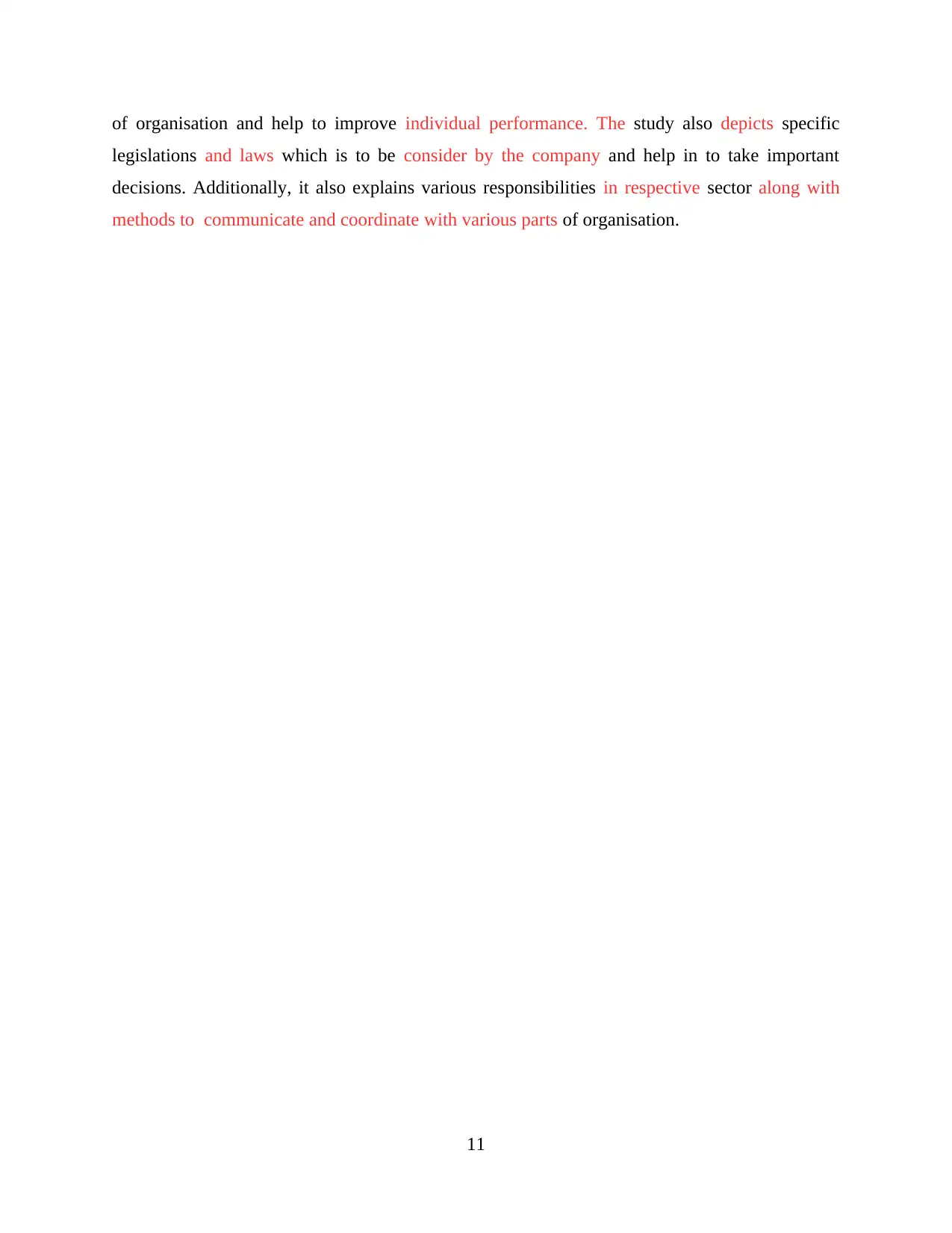
of organisation and help to improve individual performance. The study also depicts specific
legislations and laws which is to be consider by the company and help in to take important
decisions. Additionally, it also explains various responsibilities in respective sector along with
methods to communicate and coordinate with various parts of organisation.
11
legislations and laws which is to be consider by the company and help in to take important
decisions. Additionally, it also explains various responsibilities in respective sector along with
methods to communicate and coordinate with various parts of organisation.
11

12
⊘ This is a preview!⊘
Do you want full access?
Subscribe today to unlock all pages.

Trusted by 1+ million students worldwide
1 out of 14
Related Documents
Your All-in-One AI-Powered Toolkit for Academic Success.
+13062052269
info@desklib.com
Available 24*7 on WhatsApp / Email
![[object Object]](/_next/static/media/star-bottom.7253800d.svg)
Unlock your academic potential
Copyright © 2020–2025 A2Z Services. All Rights Reserved. Developed and managed by ZUCOL.





